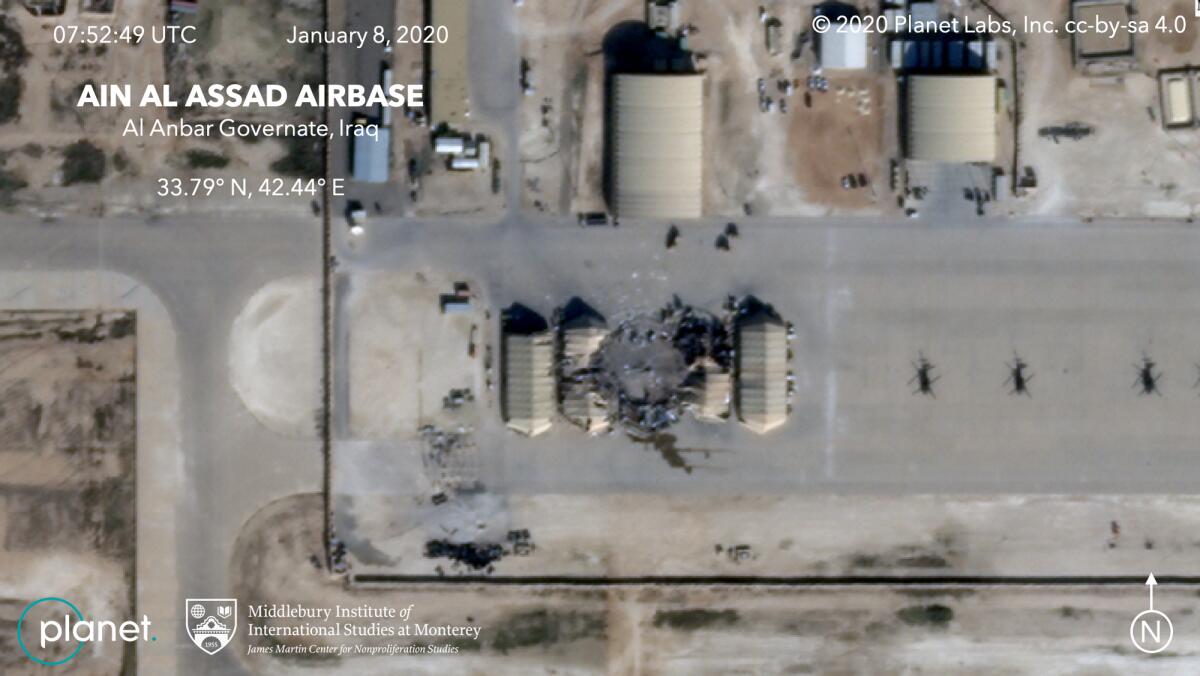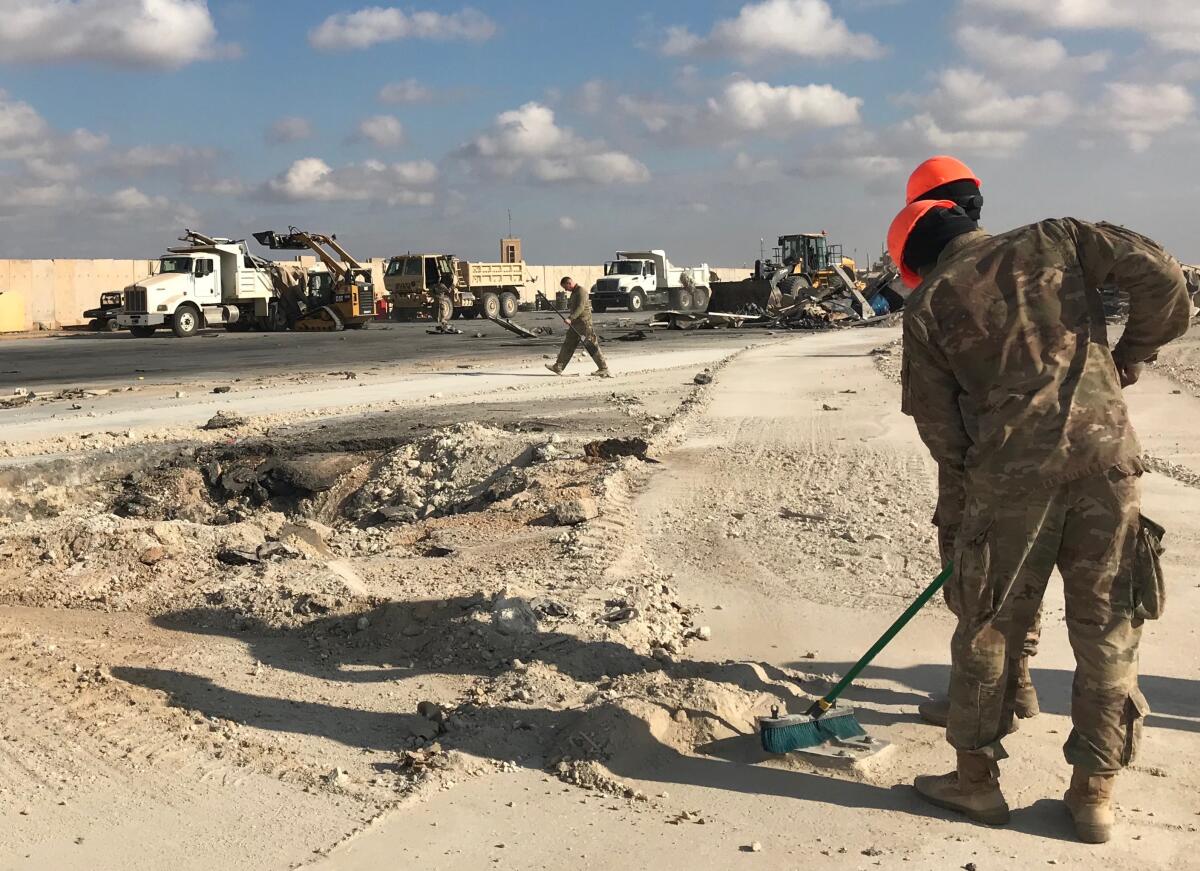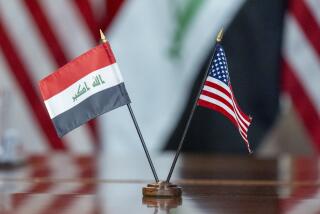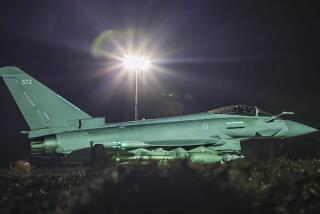U.S. service members on Iraq base describe hours-long drama during Iran missile strike

ASAD AIR BASE, Iraq — Cpl. Joel Valdivia scanned the sky. It was a little after 1:30 in the morning on Wednesday; for hours, he and the thousands of other personnel in Iraq’s Asad Air Base had been warned of an impending Iranian attack in retaliation for a U.S. drone strike that killed Gen. Qassem Suleimani.
When, where, what the attack would be, they didn’t know. Nonessential staff had already been evacuated. Others had taken shelter, while several dozen remained to staff the guard towers. Valdivia was one of them, and though “everything was pretty calm,” he said, he was tense in the cold desert night.
Then he saw the lights of the Iranian ballistic missiles streaking toward the base.
“It looked like they were a couple of thousand meters away, but I couldn’t tell,” he said.

His training kicked in: He called in the threat and hit the ground. Two minutes later, the sky around him flashed, and the tower shook.
He looked outside the tower’s back door. Scarecrow Compound, living quarters of 39 servicemen, had taken a direct hit, turning into a maelstrom of fire and smoke.
Valdivia recounted that story on Monday. The attack was the start of an hours-long ordeal, a baptism by fire for the approximately 1,500 U.S. service members, almost 500 other coalition soldiers, Iraqi troops and contractors stationed at Asad. By the end of the barrage, which lasted two hours and involved waves of ballistic missiles, there would be no casualties and little more than material damage. It was an outcome that was the result of intelligence, reconnaissance assets of dozens and training but mostly luck.
“It was miraculous,” said Lt. Col. Staci Coleman, 49, who commands the 443rd Air Expeditionary Squadron, in an interview.
Coleman, a onetime meteorologist from New York City’s Washington Heights, was still in the bunker when one of her subordinates gave her the all-clear and told her there had been no losses in the latest encounter between the U.S. and Iran in an increasingly volatile Middle East.
“I thought he was just talking about my guys. But no, he meant, none at all,” she said.
When she heard that, she added, “it was like I just got light.”
Asad Air Base — or Al Asad Air Base, what the Americans here call “Triple A-B” — sits about 120 ... sits about 120 miles west of the Iraqi capital, Baghdad, in the heart of the western province of Anbar. Built in 1987 by a consortium of Yugoslavian companies, it was known at the time as Qadisiya, a reference to the site of a historic battle in the time of Muslim conquest, a period frequently evoked by Iraqi strongman Saddam Hussein in his years-long war with Iran.
The base now houses many members of the U.S.-led coalition, which was formed in 2014 to fight Islamic State. The word often used to describe Asad is sprawling, but sparse is a better description. Foreign troops here roam a lunar-esque landscape, with bulldozers, Humvees and bug-like mine-resistant vehicles shuttling among a collection of drab brown Quonset huts, tents, prefabricated structures and Hesco barriers, all bordered by a high berm of rock and sand.
Scarecrow Compound lies slightly to the north of Asad’s runway. It’s a collection of shipping containers bunched together in a corrugated metal-topped structure, put together to form living quarters for the roughly 130 servicemen and contractors involved in flying and maintaining the U.S. Army’s Gray Eagle drones. On the night of the attack, all seven of the “birds” were in flight, monitoring areas across Iraq for enemy activity.
The vigilance was not misplaced. The start of the year had been marked by heightened tensions with Tehran. On Jan. 3, the U.S. had tracked down a flight carrying Suleimani, head of Iran’s Quds Force, an elite branch within the Islamic Revolutionary Guard Corps, and killed him as he left Baghdad airport. Killed alongside him was Abu Mahdi Muhandis, a top Iraqi militia leader. Iran and the dozens of Iraqi paramilitary factions it supports vowed revenge.
Those tensions had already caused the suspension of the coalition’s anti-Islamic State activities as well as the training operations it had run with Iraqi units. On Tuesday afternoon, reports filtered in of a possible attack on Asad. By 11 p.m., the base was in lockdown, while Coleman and other commanders had already activated “a dispersal plan,” in which much of the personnel on base would scatter to reduce the chance of being hit.
Army 1st Sgt. Wesley Kilpatrick, 38, was not one of them.
“The air force took off in planes. Helicopter pilots took off in helicopters. Special ops went in tactical vehicles. We kinda stayed here,” he said, with a slight smile.
“We had the birds out and tried to protect the base,” he added, by way of explanation.
When the first fusillade slammed down at roughly 1:35 a.m., while other members of his company were either in a bunker or some kind of shelter away from the soft-topped confines of Scarecrow Compound, Kilpatrick was still out in the open making last-minute checks.
A veteran of seven tours, including a number in Iraq, Afghanistan and Africa, he said the strike “was stronger than anything I’ve been in.”
“You got hit with the shock wave. It was blowing out doors and windows. Everything was bouncing around … you’re bouncing around,” he said.
The cruise missile drilled into the concrete floor of Scarecrow Compound, leaving a crater. The explosion sent a pair of T-walls crashing on top of a “duck-’n-cover bunker” a scant 10 yards from the blast site. A fire broke out, consuming the service members’ belongings as if they were kindling.
“These are living quarters, so I didn’t expect them to burn so fast. If people were inside…,” said Kilpatrick, his voice trailing off.
Elsewhere on the base was Air Force Capt. Patrick Livingstone. He too was one of the officers who stayed behind and waited for the strikes.
“Honestly it’s hard to describe: You don’t want to overreact until something is imminent, so you don’t spin yourself up for no reason,” said Livingstone, 30, from South Carolina.
“It’s kind of like a long-distance run, checking everyone is there. And once the attack starts, you’re sprinting.”
It was different for 26-year-old Staff Sgt. Costin Herwig. He had been too preoccupied with flying his drone in a command center near the runway to even realize the attack had begun. He described the moments after the initial strike as something from “a movie scene.”
“There was smoke everywhere,” he said, his voice recounting the night’s events with tired wonder.
The initial strike burned through the drone’s fiber-optic uplink, meaning Herwig had no way to communicate with his machine but could still receive its video feed. That too soon went out. He scrambled to get his colleagues away from the scant shelter of the command center and hurried them into bunkers.
“I accepted I was going to die. My mind was trying to play catch-up,” he said.
The barrage continued, separated by 15 to 30 minutes of calm in which commanders scrambled to take account of their personnel.
“It was absolutely a tense moment,” Livingstone said. “We had an initial round of answers, but then it took minutes to get answers from others. Those were the posts closer to the hits.”
Two hours and five fusillades later, the all-clear signal came through. Minutes after a check, troops were again staffing the towers in a show of force; Herwig and his colleagues raced to restore their uplink and get the drones to land. The rhythm of Triple A-B started up quickly, surveying the damage.
“It was incredible. I’m finding shrapnel peppering everything around. Cars. Buildings. All this stuff. But not a single soldier got a cut,” said Kilpatrick.
By dawn, much was already back in place. Even the contractors had started to clear the debris. More than 30 hours after lockdown, Herwig went back to his barracks.
It had been a long day, but he looked around him. No one was missing.
“Seeing all their faces,” he said, pausing for a moment as he searched for the word, “it was nice.”
More to Read
Sign up for Essential California
The most important California stories and recommendations in your inbox every morning.
You may occasionally receive promotional content from the Los Angeles Times.











